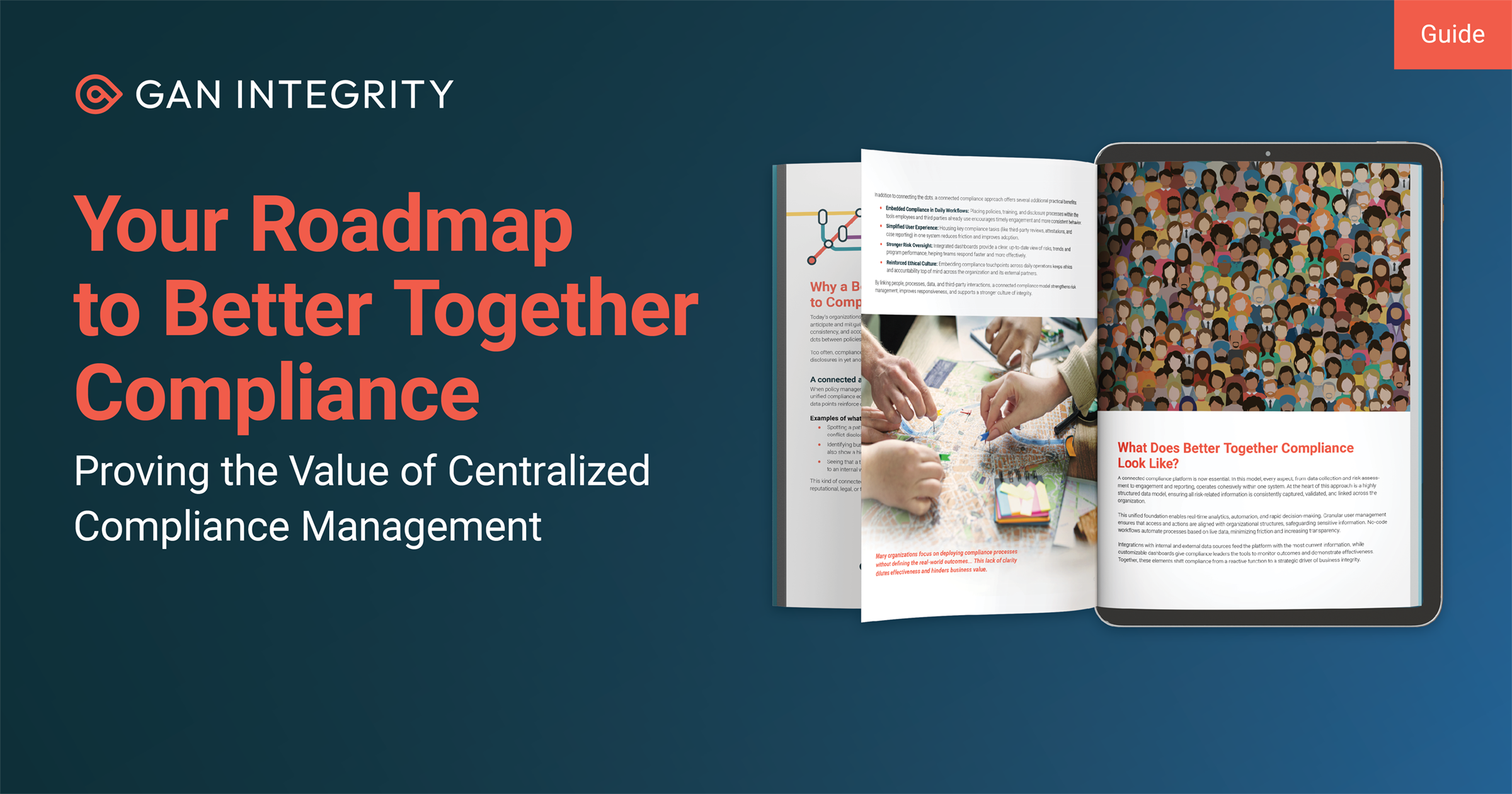In today’s increasingly complex regulatory environment, organizations face heightened scrutiny over how they manage third-party relationships and internal compliance campaigns, including conflicts of interest, gifts and entertainment, and whistleblowing. Traditional, siloed approaches to these processes no longer suffice.
Now, things are better together. Leading organizations are adopting centralized compliance software that seamlessly connects third-party risk management (TPRM) with disclosure programs into the entire compliance ecosystem to minimize risk, centralize workflows, enhance security, and cultivate an efficient, compliant culture.
This blog explores why integrating TPRM with disclosures through modern technology is not only better but a critical strategy for enterprise resilience.
Why Connected Compliance Is Better
A connected compliance platform brings together TPRM, compliance initiatives, and disclosure management, once fragmented across spreadsheets, emails, and separate systems, into a single, cohesive environment. This centralized foundation delivers multiple business benefits:
Holistic Risk Management: By monitoring third-party risks alongside internal compliance programs, compliance teams gain a complete picture of potential threats and conflicts, allowing for timely and coordinated interventions.
Process Centralization and Standardization: Centralizing TPRM tools and campaigns (like disclosures) ensures that policies, workflows, and actions are consistent across all departments and business units.
Efficient Compliance Operations: Automation and integrated workflows cut down manual tasks, reduce duplication of effort, and promote efficient remediation of issues.
Security and Confidentiality: Sensitive information, including whistleblower reports and COI attestation, is protected in a secure, role-based environment, ensuring privacy and compliance with global regulations.
Audit Readiness and Transparency: A single platform creates a comprehensive record of all risk and disclosure-related activities, simplifying regulatory audits and demonstrating program effectiveness.
Minimizing Risk: Connected TPRM in Action
Third-party relationships inherently introduce risk; vendors, suppliers, and other partners may unintentionally or maliciously create exposures through bribery, corruption, or regulatory violations. Overlaying this with inadequate internal disclosure management, such as missed or poorly tracked conflicts of interest or gifts, multiplies organizational risk.
Centralized compliance software allows organizations to connect and cross-reference third-party risk data with employee disclosures:
Conflicts of Interest (COI)
By assessing both the third-party profile and related COI disclosures in a single system, compliance can detect situations where employee interests may overlap with vendor activities, flagging them for review and mitigation.
Gifts and Entertainment
Integrated management makes it possible to track gifts and entertainment records not only by employees but also by associated third parties. This holistic visibility can highlight patterns or red flags, like repeated gifting to a single vendor, long before they become enforcement or reputational issues.
Whistleblowing
When whistleblower reports are connected with third-party and internal risk data, organizations gain valuable insight into the broader operational and compliance context, speeding up investigations and root cause analysis.
Centralizing Processes: A “Single Source of Truth”
Centralization is the bedrock of a modern compliance strategy. Consolidating all compliance campaigns, disclosures, and third-party risk activities on a single platform eliminates data silos, provides consistent procedures, and enhances organization-wide visibility. GAN Integrity’s compliance platform, for example, brings together:
- Third-party risk assessments and ongoing monitoring
- Conflicts of interest, gifts, travel, and entertainment disclosures
- Whistleblowing and incident reporting
All risk and disclosure data is connected to centralized third-party and employee profiles, giving compliance teams a 360-degree view of organizational exposure. This single source of truth makes it easy to produce actionable reports, track remediation status, and address issues proactively.
Driving Better Efficiency and Accountability
Disconnected processes often result in bottlenecks, inconsistent record-keeping, and increased administrative workload. With a unified compliance platform, organizations enable:
- Automated Workflows: Dynamic workflows allow for automatic risk-based triage. For example, low-risk disclosures can be auto-resolved, while higher-risk items are escalated for further investigation.
- Role-Based Access: Employees, managers, and compliance teams interact only with information and actions relevant to their roles, improving efficiency while maintaining confidentiality.
- Remediation Tracking: The platform enables assigning, tracking, and escalating remediation tasks—all with automated reminders and transparent audit trails, ensuring timely resolution.
By embedding these efficiencies, compliance teams can devote more time to risk analysis and program improvement, rather than redundant administrative work.
Security, Privacy, and Regulatory Alignment
With growing concerns over data breaches and increased regulatory scrutiny (such as GDPR in Europe), securing sensitive compliance data has never been more critical. Centralized compliance platforms offer robust protections:
- Role-Based Security: Highly sensitive disclosures (e.g., whistleblower reports) are accessible only to authorized individuals, safeguarding identities and restricting unnecessary access.
- Audit Trails and Documentation: Every action, submission, and investigation is logged. This not only strengthens regulatory compliance but also enhances trust and transparency for all stakeholders.
- Regulatory Mapping: Modern solutions help align compliance practices with evolving global standards, from privacy legislation to anti-bribery or labor laws.
The Benefits of Connecting TPRM and Compliance Activities
Integrating TPRM tools with compliance campaigns has far-reaching benefits:
Enhanced Risk Visibility: Connecting third-party, employee, and incident data surfaces complex, multi-factor risks that may otherwise go undetected.
Rapid Incident Response: Cross-referencing disclosure and risk data enables faster, more informed responses to incidents, reducing potential impact.
Improved Program Adoption: Employees are more likely to disclose potential conflicts or report incidents when they can access an intuitive, all-in-one platform, reducing friction and confusion.
Continuous Improvement: Centralized data and analytics enable compliance leaders to spot trends, tailor training, and evolve policies based on real-time insights.
Best Practices: Building a Better Connected Compliance Ecosystem
Implementing an integrated compliance strategy requires alignment between people, processes, and technology.
1. Design for Adaptability
Build processes and workflows that can adapt as risks change or regulations evolve. A configurable platform allows compliance teams to update controls and forms without lengthy IT projects.
2. Unify Your Compliance Ecosystem
Integrate TPRM, COI, gifts, and whistleblowing with other compliance areas such as policy management and training. Unified campaigns ensure employees can move seamlessly from learning about ethical conduct to disclosing real-world issues—all within the same platform.
3. Foster Transparency and Ownership
Leverage role-based workflows to empower employees, managers, and risk teams to participate actively in compliance. Clear documentation and automated action tracking close the loop on disclosures and investigations.
4. Automate Routine and Risk-Based Actions
Dynamic workflows and AI-powered analytics identify and resolve low-risk issues automatically while escalating complex risks to the right stakeholders. Automation reduces manual effort and enhances risk detection accuracy.
5. Prioritize User Experience
Compliance programs succeed when participation is easy and intuitive. Platforms should feature clear dashboards, mobile accessibility, and multilingual support to maximize global engagement and disclosure rates.
How the Right Compliance Software Makes It Better
The shift toward an integrated compliance ecosystem is driven by advances in technology. The latest platforms offer features essential for leading compliance programs:
- Configurable, No-Code Workflows: Easily adjust processes as business needs or regulatory landscapes shift, without relying on IT intervention.
- Integrated Dashboards and Analytics: Real-time views provide immediate insight into risk posture, disclosure rates, and outstanding actions, supporting data-driven decision-making.
- API and System Integration: Seamless connections to procurement, HR, and other enterprise tools ensure consistency and efficiency.
- Scalability: Whether for regional businesses or global enterprises, the architecture handles growth and complexity without sacrificing performance.
GAN Integrity’s TPRM software and COI tools help teams connect all core compliance and risk activities, supporting organizations at any stage of maturity, and enabling defensible, auditable records for regulatory and stakeholder review.
Better Together: The Future is Connected and Cohesive
In a world where risk and regulation are in constant flux, the organizations that thrive will be those that embed compliance deeply and naturally into their operations. A centralized compliance platform that brings together TPRM, COI, gifts and entertainment, and whistleblowing management is no longer optional; it’s essential.
The right technology translates best practices into daily action, minimizes friction, and empowers everyone in the organization to uphold the values of integrity, safety, and resilience.
With a unified approach, enterprises move beyond box-ticking and manual data wrangling to a dynamic, defensible posture that anticipates and manages risk proactively, simplifies compliance for employees, and demonstrates accountability to regulators, customers, and partners alike.
Better together compliance is the future, and the organizations that embrace it today will set the benchmark for operational transparency and ethical leadership tomorrow.
Want to learn more about how the right better together compliance software helps you mature your programs? Speak to an expert today.

Hannah Tichansky is the Content and Social Media Manager at GAN Integrity. Hannah holds over 13 years of writing and marketing experience, with 8 years of specialization in the risk management, supply chain, and ESG industries. Hannah holds an MA from Monmouth University and a Certificate in Product Marketing from Cornell University.
